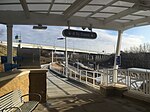Cleveland

Cleveland ( KLEEV-lənd), officially the City of Cleveland, is a major city in the U.S. state of Ohio and the county seat of Cuyahoga County. It is located along the southern shore of Lake Erie, across the U.S. maritime border with Canada and approximately 60 miles (100 kilometers) west of the Ohio-Pennsylvania state border. Cleveland is located in the Northeast region of Ohio, which is the most populous portion of the state and the most reliably Democratic region in Ohio. Cleveland is a part of the rust belt region of the United States. The current Mayor of Cleveland is Justin Bibb (D). The largest city on Lake Erie and one of the most populous urban areas in the country, Cleveland anchors the Greater Cleveland Metropolitan Statistical Area (MSA) and the Cleveland–Akron–Canton Combined Statistical Area (CSA). The CSA is the most populous combined statistical area in Ohio and the 17th largest in the United States, with a population of 3,633,962 in 2020. The city proper, with a 2020 population of 372,624, ranks as the 54th-largest city in the U.S., as a larger portion of the metropolitan population lives outside the central city. The seven-county metropolitan Cleveland economy, which includes Akron, is the largest in the state. Cleveland was founded in 1796 near the mouth of the Cuyahoga River by General Moses Cleaveland, after whom the city was named. It grew into a major manufacturing center due to its location on both the river and the lake shore, as well as numerous canals and railroad lines. A port city, Cleveland is connected to the Atlantic Ocean via the Saint Lawrence Seaway. The city's economy relies on diversified sectors such as manufacturing, financial services, healthcare, biomedicals, and higher education. The gross domestic product (GDP) for the Greater Cleveland MSA was $135 billion in 2019. Combined with the Akron MSA, the seven-county Cleveland–Akron metropolitan economy was $175 billion in 2019, the largest in Ohio, accounting for 25% of the state's GDP.Designated as a "Gamma -" global city by the Globalization and World Cities Research Network, the city's major cultural institutions include the Cleveland Museum of Art, the Cleveland Museum of Natural History, the Cleveland Orchestra, Playhouse Square, and the Rock and Roll Hall of Fame. Known as "The Forest City" among many other nicknames, Cleveland serves as the center of the Cleveland Metroparks nature reserve system. The city's major league professional sports teams include the Cleveland Browns, the Cleveland Cavaliers, and the Cleveland Guardians.
Excerpt from the Wikipedia article Cleveland (License: CC BY-SA 3.0, Authors, Images).Cleveland
Rockefeller Avenue, Cleveland
Geographical coordinates (GPS) Address Nearby Places Show on map
Geographical coordinates (GPS)
| Latitude | Longitude |
|---|---|
| N 41.482222222222 ° | E -81.669722222222 ° |
Address
Rockefeller Avenue
Rockefeller Avenue
44115 Cleveland
Ohio, United States
Open on Google Maps





